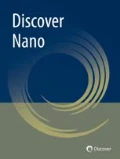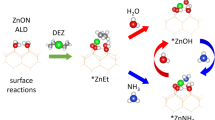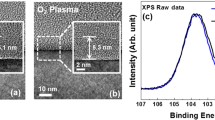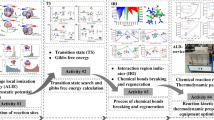Abstract
Atomic layer deposition (ALD) is a powerful deposition technique for constructing uniform, conformal, and ultrathin films in microelectronics, photovoltaics, catalysis, energy storage, and conversion. The possible pathways for silicon dioxide (SiO2) ALD using silicon tetrachloride (SiCl4) and water (H2O) without a catalyst have been investigated by means of density functional theory calculations. The results show that the SiCl4 half-reaction is a rate-determining step of SiO2 ALD. It may proceed through a stepwise pathway, first forming a Si-O bond and then breaking Si-Cl/O-H bonds and forming a H-Cl bond. The H2O half-reaction may undergo hydrolysis and condensation processes, which are similar to conventional SiO2 chemical vapor deposition (CVD). In the H2O half-reaction, there are massive H2O molecules adsorbed on the surface, which can result in H2O-assisted hydrolysis of the Cl-terminated surface and accelerate the H2O half-reaction. These findings may be used to improve methods for the preparation of SiO2 ALD and H2O-based ALD of other oxides, such as Al2O3, TiO2, ZrO2, and HfO2.
Similar content being viewed by others
Background
Atomic layer deposition (ALD) is a powerful deposition technique for constructing uniform, conformal, and ultrathin films in microelectronics, photovoltaics, catalysis, energy storage, and conversion [1,2]. Compared to other fabrication techniques, such as physical vapor deposition (PVD) and chemical vapor deposition (CVD), ALD is capable of accurately controlling the thickness of thin films at the atomic scale [1]. Essentially, the principle of ALD is similar to that of CVD, except that ALD breaks the CVD reaction into two half-reactions and retains two precursors separately during the reaction [2]. Taking silicon dioxide (SiO2) as an example, SiO2 CVD using silicon tetrachloride (SiCl4) and water (H2O) can be divided into two half-reactions, A and B, of SiO2 ALD [3-6]:
where an asterisk designates the surface species.
In order to get more insight into the reaction mechanism of SiO2 ALD, theoretical calculation has been performed that illustrates the reaction pathways [7]. It was proposed that on the Si(001) surface, the substituted half-reaction of SiCl4 with surface hydroxyl group (−OH) proceeds through a concerted pathway via a four-membered ring (4MR) transition state (TS), forming Si-O and H-Cl bonds while simultaneously breaking Si-Cl and O-H bonds [7]. Unlike the Lewis acids, such as AlCl3, TiCl4, ZrCl4, and HfCl4, however, SiCl4 seems to have no strong nucleophilicity [8-10]. Furthermore, it was found experimentally that the rate-determining step (RDS) of the full cycle of SiO2 ALD is the SiCl4 half-reaction, not the H2O half-reaction [3-6]. To date, the reaction mechanism of the full SiO2 ALD process on the actual SiO2 surface has remained unclear. In this work, we have performed detailed density functional theory (DFT) calculations to investigate the reaction mechanism of the full cycle of SiO2 ALD, involving the SiCl4 half-reaction (A1 and A2) and H2O half-reaction (B1 to B10), as shown in Figure 1. It is demonstrated that the SiCl4 half-reaction may undergo a stepwise pathway and H2O can accelerate the H2O half-reaction. The insights gained into the reaction mechanism of SiO2 ALD may be used to improve methods for SiO2 ALD and H2O-based ALD of other oxides, such as Al2O3, TiO2, ZrO2, and HfO2.
Methods
In order to model the two half-reactions of SiO2 ALD, we adopt the cluster model Si23O40H40, as shown in Figure 2, which is based on a hydroxylated α-SiO2(0001) surface. The cluster model consists of three layers of SiO2 (Si23O40), and 40 hydrogen atoms which are used to saturate the dangling bonds. To stimulate the surface, the lower two layers of the SiO2 atoms of the two models were fixed in optimized geometries.
All the species in ALD SiO2 reactions were optimized using the M06-2X functional within the framework of DFT [11,12]. In order to gain a compromise between accuracy and computational cost, the 6-31G basis set was used for the fixed atoms of the substrate and the 6-31G(d,p) basis set was employed for other atoms on the surface. For each stationary point on the potential energy surface, a frequency calculation was carried out to determine if it is a minimum or a TS. All the transition states were verified by intrinsic reaction coordinates (IRC) calculations. Gibbs free energies of all species were estimated from the partition functions, and the enthalpy and entropy terms at 600 K. The energies reported here include zero-point energy (ZPE) corrections. We note that the solid surface lacks translational and rotational freedom, and the entropy of the surface only has a vibrational contribution. In other words, after being adsorbed onto the surface, the gas molecules lose translational and rotational momenta and produce new vibrational modes. All calculations in this work were performed with Gaussian 09 program [13].
Results and discussion
SiCl4 half-reaction: stepwise mechanism
The reaction pathway for the SiCl4 half-reaction between SiCl4 precursor and the surface hydroxyl (-OH) is shown in Figure 3. Due to high levels of hydroxyls on the SiO2 surface after H2O half-reaction, SiCl4 and hydroxyl may exchange ligands twice in the SiCl4 half-reaction. Firstly, reaction A1 between SiCl4 and -OH goes through a rotation transition state, TS1A1, with a Gibbs free energy barrier (G a) of 34.5 kcal mol−1 and forms a pentacoordinated intermediate, Im2A1. Subsequently, the unstable intermediate undergoes the second transition state, TS2A1, forming the product -OSiCl3 *, PA1 and accompanied by the release of HCl. Secondly, -OSiCl3 can further react with another adjacent hydroxyl (-OH) on the surface to form the bridged product -O2SiCl2 *, PA2. Similar to reaction A1, reaction A2 between -OSiCl3 * and -OH also undergoes two transition states, TS1A2 and TS2A2, and a pentacoordinated intermediate, Im1A2. The overall SiCl4 half-reaction is exergonic by 24.0 kcal mol−1. The highest activation free energy of the SiCl4 half-reaction is 44.5 kcal mol−1 (TS2A1), indicating that the SiCl4 half-reaction is very difficult. This difficulty can be overcome by the introduction of Lewis base catalysts, such as ammonia, pyridine, and aminosilane [14-22].
In Figure 3, TS1A1 and TS1A2, with imaginary frequencies of 42i and 57i cm−1, respectively, represent the formation of a Si-O bond accompanied by the rotation of SiCl4 and -SiCl3. The pentacoordinated intermediates, Im2A1 and Im1A2, have a trigonal bipyramidal (TBP) geometry with five ligands of four Cl atoms and one O atom or three Cl atoms and two O atoms. The TS2A1 and TS2A2, with imaginary frequencies of 129i and 458i cm−1, respectively, represent cleavages of the Si-Cl and O-H bonds and the formation of a H-Cl bond. As listed in Table 1, the Si · · · O and H · · · Cl distances in reaction A1 gradually decrease from 2.01 and 2.62 Å to 1.62 and 1.29 Å, respectively, indicating the formation of new Si-O and H-Cl bonds. Simultaneously, the O-H and Si-Cl distances increase from 1.03 and 2.11 Å to 4.86 and 4.88 Å, respectively, indicating cleavage of old O-H and Si-Cl bonds. Similar to reaction A1, the Si · · · O and H · · · Cl distances in reaction A2 gradually decrease from 2.95 and 3.81 Å to 1.62 and 1.29 Å, respectively, indicating the formation of new Si-O and H-Cl bonds. Simultaneously, the O-H and Si-Cl distances increase from 0.97 and 2.05 Å to 3.44 and 4.02 Å, respectively, indicating the cleavage of these bonds.
H2O half-reaction: H2O-assisted hydrolysis
In conventional SiO2 CVD, SiCl4 and H2O are introduced into the reaction chamber simultaneously. Subsequent hydrolysis and condensation lead to the formation of SiO2. Although two reactants are separately introduced into the chamber, hydrolysis and condensation also occur in SiO2 ALD. In fact, the half-reaction between water and the Cl-terminated surface exchanges Cl and -OH ligands and changes Si-Cl* species into Si-OH* species. Due to this the possible reactions of the H2O half-reaction (B) may include the formation of silanol (-Si-OH) via the exchange of ligands between Cl and -OH (reactions B1, B2, B3, B4, and B5) and the formation of -O-Si-O- bridge bonds by removing H2O (reactions B6, B8, and B10) and HCl (reactions B7 and B9), similar to the hydrolysis (-Si-OH) and condensation (-O-Si-O-) processes of SiO2 CVD.
After the SiCl4 half-reaction, the hydroxylated surface is terminated by Cl atoms and changes to -O2SiCl2 * and -OSiCl3 * surfaces, which are both hydrolyzed in subsequent H2O half-reaction. Firstly, H2O and the bridged surface (-O2SiCl2 *) can exchange the ligands via reactions B1 and B2, shown in Figure 4. The first Cl exchange of the hydrolysis of -O2SiCl2 * requires a high activation free energy of 37.6 kcal mol−1 and goes through a transition state, TS1B1, to form -Si-OH* species and release HCl from the surface. Subsequently, the second Cl atom of -O2SiCl2 * can also be exchanged by -OH via a transition state, TS1B2, with an activation free energy of 31.7 kcal mol−1. If H2O-assisted role is considered, the activation free energy of the hydrolysis of -O2SiCl2 * decreases to approximately 21.2 kcal mol−1, indicating that H2O can accelerate -Si-OH formation and Cl elimination. The reason for this is mainly that H2O can form hydrogen bonding interactions through H2O…H2O bonds and lower the activation energy of Si-O bond formation and Cl elimination via a six-member ring (6MR) transition state, H2O-assisted-TS1B1, shown in Figure 4. The accelerated half-reaction via the hydrogen bonding interaction of H2O…H2O may be termed as H2O-assisted hydrolysis, which is similar to Lewis-base catalysis in SiO2 ALD through the OH…N hydrogen bond [14,23,24]. As a matter of fact, there are H2O-assisted reactions in nature, such as hydrolysis or solvolysis [25-28], tautomerization or proton transfer [29-34], decomposition [35-37], and catalysis [38,39]. H2O-assisted hydrolysis and solvolysis facilitate the exchange and dissociation of Cl ligand in HfO2 ALD using HfCl4 and H2O [40].
Secondly, another Cl-terminated surface (-OSiCl3 *) can also hydrolyze step-by-step and go through pathways, B3, B4, and B5, shown in Figure 5. Three ligand exchange reactions undergo two transition states, TS1B3 and TS2B3, TS1B4 and TS2B4, and TS1B5 and TS2B5. Similar to the SiCl4 half-reaction, the first represents the formation of Si-O bonds and the second represents the cleavages of Si-Cl and O-H bonds and the formation of H-Cl bond. It is found that the activation free energies of -OSiCl3 * hydrolysis are lower than that of -O2SiCl2 * hydrolysis. Unlike the rigid -O2SiCl2 group, the -OSiCl3 group is more flexible. As shown in TS1B3 of Figure 5, the hydroxyl (-OH) on the surface can interact with H2O through hydrogen bonding, HOH…OH, and cause the rotation of the -OSiCl3 group, which can accelerate the hydrolysis of -OSiCl3 and H2O exchange with the Cl ligand. The first hydrolysis of -OSiCl3 * requires a low activation free energy of 23.3 kcal mol−1; however, the hydrolysis of -OSiOH-Cl2 * and -OSi(OH)2-Cl* require slightly higher activation free energies. The reason for this may be that the direction of the hydrolyzed Cl atom of -OSiCl3 * is more downward than that of -OSiOH-Cl2 * or -OSi(OH)2-Cl*, which results in a hydrogen bonding interaction between -OH and H2O. In the H2O half-reaction, there are massive H2O molecules adsorbed on the surface, which result in H2O-assisted hydrolysis. Owing to the strong hydrogen bonding interaction of H2O · · · H2O, a pentacoordinated intermediate including silanol (Si-OH) ligand can be directly formed, as shown in H2O-assisted Im2B3 in Figure 5. The hydrolysis of -OSiCl3 * and the elimination of Cl ligand occur easily and the activation free energy can decrease from 23.3 to 15.0 kcal mol−1. Similarly, H2O can also accelerate the hydrolysis of -OSiOH-Cl2 * and -OSi(OH)2-Cl*.
Gibbs free energy profiles of the hydrolysis reactions of -OSiCl 3 * , B3, B4, and B5, in H 2 O half-reaction. The inset shows the structures of seven transition states, TS1B3, TS2B3, TS1B4, TS2B4, TS1B5, TS2B5, and H2O-assisted-TS2B3, a pentacoordinated intermediate, H2O-assisted-Im2B3, and three products, PB3, PB4, and PB5.
As show in Figure 6, the formation of the O-Si-O bridge bond can result from H 2 O condensation reactions, B6, B8, and B10, similar to the condensation (O-Si-O) process of SiO2 CVD. These condensation reactions occur after the hydrolysis of -OSiCl3 *, -OSiOH-Cl2 * and -OSi(OH)2-Cl* and include two transition states. The first transition states, TS1B6, TS1B8, and TS1B10, represent O-Si-O bond formation with the activation free energies of 22.9, 21.6, and 18.1 kcal mol−1, respectively. The second transition states, TS2B6, TS2B8, and TS2B10, represent H2O removal with the activation free energies of 21.9, 18.6, and 19.8 kcal mol−1, respectively.
Similar to H2O condensation, HCl condensation reactions, B7 and B9, can also result in the formation of the O-Si-O bridge bond with low activation free energies of 22.4 and 21.6 kcal mol−1, respectively, as show in Figure 7. The corresponding activation free energies of HCl removal are 18.6 and 12.6 kcal mol−1, respectively. During H2O or HCl removal, the two condensations both lead to the formation of the O-Si-O bridge bond, which is the elementary unit of SiO2 and ensures its ALD growth.
When reviewing the full SiO2 ALD cycle, including reactions A1 to A2 and B1 to B10, we find that the free energy barrier for the H2O half-reaction is lower than that for SiCl4 half-reaction. The principal reason is that there are massive H2O molecules adsorbed on the surface, which result in H2O-assisted hydrolysis of -O2Si-Cl2 *, -O2SiOH-Cl*, -OSi-Cl3 *, -OSiOH-Cl2 *, and -OSi(OH)2-Cl* and accelerate the H2O half-reaction. Therefore, the SiCl4 half-reaction is the RDS of the full ALD cycle of SiO2 and controls the ALD growth of SiO2.
Conclusions
Through detailed DFT calculations, the possible reaction pathways of (A) SiCl4 half-reaction and (B) H2O half-reaction in SiO2 ALD without a catalyst have been investigated. The SiCl4 half-reaction is the RDS of SiO2 ALD. It may proceed through a stepwise pathway, first forming a Si-O bond and then breaking Si-Cl and O-H bonds and forming a H-Cl bond. The H2O half-reaction is a complicated process, including hydrolysis and condensation. In the H2O half-reaction, there are massive H2O molecules adsorbed on the surface, which can result in H2O-assisted hydrolysis of the Cl-terminated surface and accelerate the H2O half-reaction. These findings may be used in SiO2 ALD and H2O-based ALD of other oxides, such as Al2O3, TiO2, ZrO2, and HfO2.
References
Doering R, Nishi Y. Handbook of semiconductor manufacturing technology. 2nd ed. Boca Raton: CRC; 2007.
Pinna N, Knez M. Atomic layer deposition of nanostructured materials. New York: Wiley-VCH; 2011.
George SM, Sneh O, Dillon AC, Wise ML, Ott AW, Okada LA, et al. Atomic layer controlled deposition of SiO2 and Al2O3 using ABAB… binary reaction sequence chemistry. Appl Surf Sci. 1994;82–83:460–7.
Sneh O, Wise ML, Ott AW, Okada LA, George SM. Atomic layer growth of SiO2 on Si(100) using SiCl4 and H2O in a binary reaction sequence. Surf Sci. 1995;334:135–52.
George SM, Ott AW, Klaus JW. Surface chemistry for atomic layer growth. J Phys Chem. 1996;100:13121–31.
Klaus JW, Ott AW, Johnson JM, George SM. Atomic layer controlled growth of SiO2 films using binary reaction sequence chemistry. Appl Phys Lett. 1997;70:1092–4.
Kang JK, Musgrave CB. Mechanism of atomic layer deposition of SiO2 on the silicon (100)-2 × 1 surface using SiCl4 and H2O as precursors. J Appl Phys. 2002;91:3408–14.
Ritala M, Kukli K, Rahtu A, Räisänen PI, Leskelä M, Sajavaara T, et al. Atomic layer deposition of oxide thin films with metal alkoxides as oxygen sources. Science. 2000;288:319–21.
Hausmann D, Becker J, Wang S, Gordon RG. Rapid vapor deposition of highly conformal silica nanolaminates. Science. 2002;298:402–6.
Fang G, Ma J. Rapid atomic layer deposition of silica nanolaminates: synergistic catalysis of Lewis/Brønsted acid sites and interfacial interactions. Nanoscale. 2013;5:11856–69.
Zhao Y, Truhlar DG. Density functionals with broad applicability in chemistry. Acc Chem Res. 2008;41:157–67.
Zhao Y, Truhlar DG. The M06 suite of density functionals for main group thermochemistry, thermochemical kinetics, noncovalent interactions, excited states, and transition elements: two new functionals and systematic testing of four M06-class functionals and 12 other functional. Theor Chem Acc. 2008;120:215–41.
Frisch MJ, Trucks GW, Schlegel HB, Scuseria GE, Robb MA, Cheeseman JR, et al. Gaussian 09. Revision B.02. Wallingford CT: Gaussian, Inc; 2009.
Klaus JW, Sneh O, George SM. Growth of SiO2 at room temperature with the use of catalyzed sequential half reaction. Science. 1997;278:1934–6.
Klaus JW, Sneh O, Ott AW, George SM. Atomic layer deposition of SiO2 using catalyzed and uncatalyzed self-limiting surface reactions. Surf Rev Lett. 1999;6:435–48.
Klaus JW, George SM. Atomic layer deposition of SiO2 at room temperature using NH3-catalyzed sequential surface reactions. Surf Sci. 2000;447:81–90.
Klaus JW, George SM. SiO2 chemical vapor deposition at room temperature using SiCl4 and H2O with an NH3 catalyst. J Electrochem Soc. 2000;147:2658–64.
Ferguson JD, Smith ER, Weimer AW, George SM. ALD of SiO2 at room temperature using TEOS and H2O with NH3 as the catalyst. J Electrochem Soc. 2004;151:G528–35.
Du Y, Du X, George SM. SiO2 film growth at low temperatures by catalyzed atomic layer deposition in a viscous flow reactor. Thin Sol Film. 2005;491:43–53.
Du Y, Du X, George SM. Mechanism of pyridine-catalyzed SiO2 atomic layer deposition studied by Fourier transform infrared spectroscopy. J Phys Chem C. 2007;111:219–26.
Hatton B, Kitaev V, Perovic D, Ozin G, Aizenberg J. Low-temperature synthesis of nanoscale silica multilayers - atomic layer deposition in a test tube. J Mater Chem. 2010;20:6009–13.
Bachmann J, Zierold R, Chong YT, Hauert R, Sturm C, Schmidt-Grund R, et al. A practical, self-catalytic, atomic layer deposition of silicon dioxide. Angew Chem Int Ed. 2008;47:6177–9.
Fang G, Chen S, Li A, Ma J. Surface pseudorotation in Lewis-base-catalyzed atomic layer deposition of SiO2: static transition state search and Born − Oppenheimer molecular dynamics simulation. J Phys Chem C. 2012;116:26436–48.
Fang GY, Xu LN, Cao YQ, Wang LG, Wu D, Li DL. Self-catalysis by aminosilanes and strong surface oxidation by O2 plasma in plasma-enhanced atomic layer deposition of high-quality SiO2. Chem Commun. 2015;51:1341–4.
Antonczak S, Ruiz-Lόpez MF, Rivail JL. Ab initio analysis of water-assisted reaction mechanisms in amide hydrolysis. J Am Chem Soc. 1994;116:3912–21.
Schmeer G, Sturm P. A quantum chemical approach to the water assisted neutral hydrolysis of ethyl acetate and its derivatives. Phys Chem Chem Phys. 1999;1:1025–30.
Tsuchida N, Satou H, Yamabe S. Reaction paths of the water-assisted solvolysis of N, N-dimethylformamide. J Phys Chem A. 2007;111:6296–303.
Gao JY, Zeng Y, Zhang CH, Xue Y. Theoretical studies on the water-assisted hydrolysis of N, N-dimethyl-N’-(2′,3′-dideoxy-3′-thiacytidine) formamidine with three water molecules. J Phys Chem A. 2009;113:325–31.
Bell RL, Truong TN. Primary and solvent kinetic isotope effects in the water-assisted tautomerization of formamidine: an ab initio direct dynamics study. J Phys Chem A. 1997;101:7802–8.
Gu J, Leszczynski J. A DFT study of the water-assisted intramolecular proton transfer in the tautomers of adenine. J Phys Chem A. 1999;103:2744–50.
Liu GX, Li ZS, Ding YH, Fu Q, Huang XR, Sun CC, et al. Water-assisted isomerization from linear propargylium (H2CCCH+) to cyclopropenylium(c-C3H3 +). J Phys Chem A. 2002;106:10415–22.
Balta B, Aviyente V. Solvent effects on glycine II. Water-assisted tautomerization. J Comput Chem. 2004;25:690–703.
Markova N, Enchev V, Timtcheva I. Oxo-hydroxy tautomerism of 5-fluorouracil: water-assisted proton transfer. J Phys Chem A. 2005;109:1981–8.
Michalkova A, Kosenkov D, Gorb L, Leszczynski J. Thermodynamics and kinetics of intramolecular water assisted proton transfer in Na+-1-methylcytosine water complexes. J Phys Chem B. 2008;112:8624–33.
Aplincourt P, Anglada JM. Theoretical studies of the isoprene ozonolysis under tropospheric conditions. 2. Unimolecular and water-assisted decomposition of the r-hydroxy hydroperoxides. J Phys Chem A. 2003;107:5812–20.
Jacobs G, Patterson PM, Graham UM, Crawford AC, Dozier A, Davis BH. Catalytic links among the water–gas shift, water-assisted formic acid decomposition, and methanol steam reforming reactions over Pt-promoted thoria. J Cat. 2005;235:79–91.
Huang J, Yeung CS, Ma J, Gayner ER, Phillips DL. A computational chemistry investigation of the mechanism of the water-assisted decomposition of trichloroethylene oxide. J Phys Chem A. 2014;118:1557–67.
Ouchi M, Yoda H, Terashima T, Sawamoto M. Aqueous metal-catalyzed living radical polymerization: highly active water-assisted catalysis. Polym J. 2012;44:51–8.
Thorat PB, Goswami SV, Jadhav WN, Bhusare SR. Water-assisted organocatalysis: an enantioselective green protocol for the henry reaction. Aust J Chem. 2013;66:661–6.
Mukhopadhyay AB, Musgrave CB, Sanz JF. Atomic layer deposition of hafnium oxide from hafnium chloride and water. J Am Chem Soc. 2008;130:11996–2006.
Acknowledgements
This work was supported by the National Natural Science Foundation of China (51202107), the State Key Program for Basic Research of China (2015CB921203 and 2011CB922104), the China Postdoctoral Science Foundation (2014 M551556), Open Project of National Laboratory of Solid State Microstructures (M27009), and Zhejiang Provincial Natural Science Foundation of China (LY13B030005). ADL is also grateful for the support of the Doctoral Fund of the Ministry of Education of China (20120091110049) and the Priority Academic Program Development (PAPD) in Jiangsu Province. We thank the High Performance Computing Center of Nanjing University for providing the computing resources.
Author information
Authors and Affiliations
Corresponding authors
Additional information
Competing interests
The authors declare that they have no competing interests.
Authors’ contributions
GYF and ADL proposed an idea to elucidate the mechanism of SiO2 ALD. LNX, LGW, YQC, and DW participated in the calculations and helped in the data analysis. GYF and LNX wrote the paper. All authors read and approved the final manuscript.
Rights and permissions
Open Access This article is distributed under the terms of the Creative Commons Attribution 4.0 International License (https://creativecommons.org/licenses/by/4.0), which permits use, duplication, adaptation, distribution, and reproduction in any medium or format, as long as you give appropriate credit to the original author(s) and the source, provide a link to the Creative Commons license, and indicate if changes were made.
About this article
Cite this article
Fang, GY., Xu, LN., Wang, LG. et al. Stepwise mechanism and H2O-assisted hydrolysis in atomic layer deposition of SiO2 without a catalyst. Nanoscale Res Lett 10, 68 (2015). https://doi.org/10.1186/s11671-014-0714-1
Received:
Accepted:
Published:
DOI: https://doi.org/10.1186/s11671-014-0714-1











